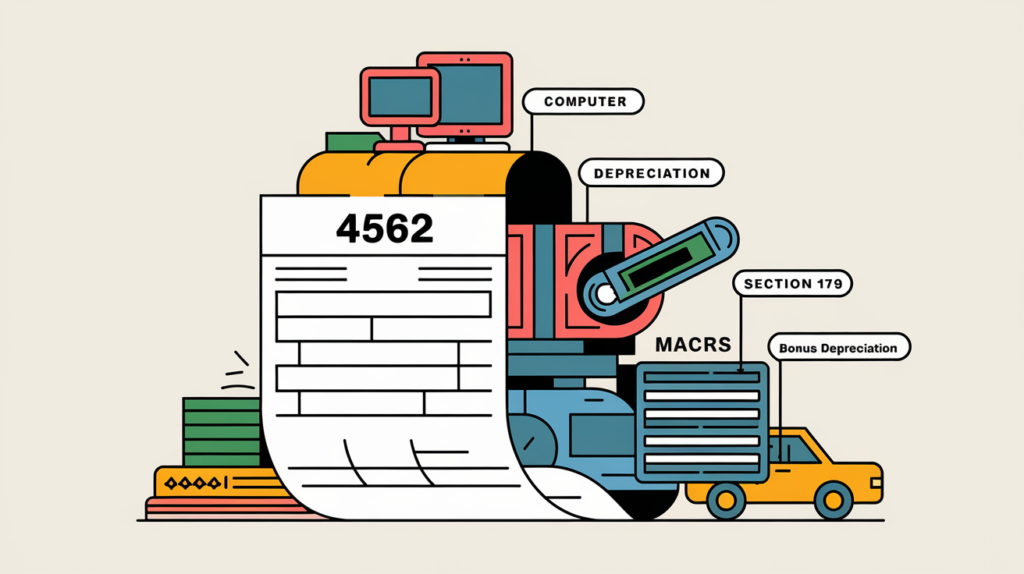Tax season can be a challenging time for business owners, especially when it comes to navigating complex IRS forms. One such form that often causes confusion is Form 4562, Depreciation and Amortization. But don’t worry, we’re here to help! Understanding this form is crucial for unlocking valuable tax deductions and saving your business money.
At XOA TAX, we understand the intricacies of Form 4562 and how it applies to the 2024 tax year. This comprehensive guide will break down the essentials, providing clear explanations and practical insights to help you confidently approach this important tax document.
Key Takeaways
- Depreciation and amortization allow businesses to recover the cost of assets over time, leading to significant tax deductions.
- Form 4562 is the IRS form used to report these deductions.
- Understanding each section of Form 4562 is crucial for accurate completion. This guide will walk you through each part.
Depreciation vs. Amortization: A Simple Analogy
Imagine you’ve purchased a new delivery van for your business for $30,000. As you use the van, it naturally experiences wear and tear and loses value over time. This decrease in value is known as depreciation. Instead of deducting the entire $30,000 cost of the van in the year you buy it, the IRS allows you to spread out this cost over several years, reflecting its declining value.
Now, let’s say your company also developed a unique software program and secured a copyright for it, costing $10,000. This copyright, an intangible asset, also loses value over time as new software emerges or technology advances. This gradual decrease in value for intangible assets is called amortization.
In essence: Depreciation applies to tangible assets (like your delivery van), while amortization applies to intangible assets (like your copyright). Both help businesses account for the gradual decrease in their assets’ value.
What is Form 4562?
Form 4562 is the key to claiming depreciation and amortization deductions. It allows you to recover the cost of eligible property over its useful life. This form is used annually to track accumulated depreciation, ensuring accurate and consistent reporting to the IRS.
Who Needs to File Form 4562?
You’ll likely need to file Form 4562 if you:
- Are claiming depreciation for assets placed in service during the 2024 tax year.
- Want to take advantage of the Section 179 expense deduction.
- Need to depreciate a vehicle or other listed property.
- Are claiming amortization of costs that began in 2024.
Important: If you have multiple businesses, you must file a separate Form 4562 for each.
Gathering the Necessary Information
Before you begin filling out Form 4562, gather the following information:
- Purchase price of the asset: This includes the initial cost and any expenses related to acquiring and placing the asset in service. Keep your receipts!
- Date the asset was placed in service: This is the date you started using the asset for business purposes.
- Your total business income: Depreciation deductions affect your taxable income, so this information is crucial for your tax return.
- Percentage of business use: If an asset is used for both business and personal purposes (like a company car), you’ll need to determine the percentage used for business. Keep detailed records, such as mileage logs, to support your claim.
Form 4562 Instructions: A Step-by-Step Guide
Completing Form 4562 can seem complicated, but with a clear understanding of each section, it becomes manageable. Refer to the official IRS instructions for Form 4562 (Publication 946, How to Depreciate Property) for further clarification.
Part I: Election To Expense Certain Property Under Section 179
Section 179 allows you to deduct the full cost of qualifying property in the first year it’s placed in service, up to a certain limit. For 2024, this limit is $1.2 million. If your eligible property costs more than $2.7 million, the deduction is reduced.
- Line 1: Enter the maximum Section 179 deduction you can claim ($1.2 million for 2024).
- Lines 4 and 5: Calculate any reduction to your deduction based on the cost of your qualifying property.
- Line 6: List the assets you’re expensing under Section 179.
- Line 13: Calculate any carryover to the next year if you couldn’t expense the entire cost in the current year.
Part II: Special Depreciation Allowance and Other Depreciation
This section deals with bonus depreciation, which allows you to deduct a percentage of the cost of qualifying property in addition to regular depreciation. For property placed in service in 2024, the bonus depreciation rate is 80%.
- Line 14: List the property you’re depreciating under the special depreciation allowance.
- Line 15: List property you’re depreciating using a method not based on a term of years (e.g., unit-of-production method).
Part III: MACRS Depreciation
MACRS (Modified Accelerated Cost Recovery System) is the standard depreciation method for most business assets. It spreads the deduction over the asset’s useful life, using different depreciation systems and conventions (e.g., General Depreciation System (GDS) with the half-year convention).
- Line 19: List assets you’re depreciating under MACRS, including their cost, recovery period, depreciation method, and calculated depreciation.
Part IV: Summary
This section summarizes the depreciation and amortization deductions from other parts of the form.
- Line 21: Report depreciation for listed property (assets used for both business and personal use).
- Line 22: Calculate your total depreciation and amortization deduction.
- Line 23: Report any costs subject to capitalization under Section 263A.
Part V: Listed Property
This section provides detailed information about listed property, such as vehicles and computers, used for both business and personal purposes.
- Line 25: Report listed property eligible for bonus depreciation.
- Lines 26 and 27: Categorize your listed property based on its primary use (business or personal).
- Lines 30-41: Provide information about vehicle usage, including mileage and business/investment use percentage.
Part VI: Amortization
This section is for reporting the amortization of intangible assets.
- Line 42: List each amortizable asset, its acquisition date, cost, amortization period, and the amount you’re deducting this year.
Illustrative Examples
Example 1: Section 179 Deduction
Let’s say you purchased a new machine for your business in 2024 for $80,000. You can choose to expense the entire cost under Section 179, reducing your taxable income by $80,000 for the year.
Example 2: Bonus Depreciation
If you purchased a qualified piece of equipment for $50,000, you could claim 80% bonus depreciation in the first year, resulting in a $40,000 deduction.
Example 3: MACRS Depreciation
A computer costing $2,000, classified under GDS with a 5-year recovery period and using the half-year convention, would have a depreciation deduction of $200 in the first year (calculated using the applicable MACRS percentage).
Common Mistakes to Avoid
- Incorrectly classifying assets: Ensure you use the correct asset class and recovery period when calculating depreciation.
- Overlooking bonus depreciation: Take advantage of bonus depreciation when available to maximize deductions.
- Not tracking business use percentage for listed property: Maintain accurate records to support your deduction.
- Forgetting to include all necessary information: Double-check that you …have included all required schedules and supporting documentation.
State-Specific Depreciation Rules
While federal tax law provides the framework for depreciation, be aware that states may have their own specific rules and limitations. For example, some states may have different bonus depreciation rates or recovery periods. Consult your state’s tax guidelines or a tax professional for clarification.
Recent Tax Law Changes
Tax laws are subject to change, and these changes can significantly impact depreciation deductions. For instance, recent legislation might have adjusted bonus depreciation rates or modified the definition of qualified property. Stay informed about the latest tax law updates or consult with a tax expert to ensure compliance and optimize your deductions.
Frequently Asked Questions (FAQ)
1. What is the difference between depreciation and amortization?
Depreciation applies to tangible assets (physical property like buildings, equipment, and vehicles), while amortization applies to intangible assets (non-physical property like patents, trademarks, and copyrights). Both methods allow businesses to deduct the cost of an asset over its useful life.
2. What is the Section 179 deduction, and how does it work?
Section 179 allows businesses to deduct the full purchase price of qualifying equipment and software, up to a certain limit, in the year it’s placed in service. This can provide significant tax savings in the first year.
3. What is listed property?
Listed property includes assets often used for both business and personal purposes, such as vehicles, computers, and cell phones. Special rules apply to depreciating these assets, and you’ll need to track their business use percentage.
4. Can I depreciate land?
No, land is not considered a depreciable asset because it doesn’t wear out or lose value over time.
5. Where can I find the latest IRS instructions for Form 4562?
You can find the most up-to-date instructions and the latest version of Form 4562 on the official IRS website: www.irs.gov.
Need Help with Form 4562?
Form 4562 can be complex, and making mistakes can be costly. If you’re unsure about any aspect of this form or need assistance with your specific situation, don’t hesitate to seek professional tax advice.
Contact XOA TAX today! Our team of experienced CPAs can help you navigate the complexities of depreciation and amortization, ensuring you claim all eligible deductions and optimize your tax strategy.
- Website: https://www.xoatax.com/
- Phone: +1 (714) 594-6986
- Email: [email protected]
- Contact Page: https://www.xoatax.com/contact-us/
We’re here to help you make sense of your taxes and achieve your financial goals.
Disclaimer: This post is for informational purposes only and does not provide legal, tax, or financial advice. Laws, regulations, and tax rates can change often. Please consult a professional advisor for advice specific to your situation.




 anywhere
anywhere  anytime
anytime